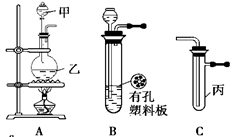(18分)某化学兴趣小组的同学利用下图所示实验装置进行实验。(图中a、b、c表示止水夹)。


请按要求填空:
(1)利用B装置可制取的气体有 (至少填2种),写出实验室里利用A装置制取氯气的离子方程式 。
(2)只用A、C、E相连后的装置用于制取Cl2并进行相关的性质实验。若在丙中加入适量水,即可制得氯水。将所得氯水分成两份,进行Ⅰ、Ⅱ两个实验,实验操作、现象结论如下:
| 实验序号 | 实验操作 | 现 象 | 结 论 |
| Ⅰ | 将氯水滴入品红溶液 | 溶液褪色 | 氯气与水反应的产物有漂白性 |
| Ⅱ | 氯水中加入 NaHCO3粉末 | 有无色气泡产生 | 氯气与水反应的产物具有较强的酸性 |
①请评价实验Ⅰ、Ⅱ的结论是否合理?若不合理,请说明理由。 (任选1个实验进行评价。)
| 实验序号 | 结论 | 理由 |
| Ⅰ | ||
| Ⅱ |
②若要利用上述A、C装置设计一个简单的实验,验证Cl2和I2的氧化性强弱,可以在甲、乙、丙中分别装入浓盐酸、MnO2、淀粉碘化钾溶液,根据丙中产生的现象是 ,则可证明Cl2的氧化性强于I2 。
(3)B、D、E装置相连后,在B中盛装足量浓硝酸和铜片(放在有孔塑料板上),可制得NO2并进行有关实验。
①B中发生反应的化学方程式 。
② 欲用D装置验证NO2与水的反应,其操作步骤:先关闭止水夹 (填写a、b或c),再打开止水夹 (填写a、b或c),若要使D烧杯中的水进入试管丁的操作是:通过 试管丁,使试管丁的NO2气体逸出,NO2与水接触后即可引发烧杯中的水倒流进入试管丁。
⑴ H2、CO2、H2S等(2分) MnO2+2Cl -+4H+  Mn2++Cl2↑+2H2O(2分)
Mn2++Cl2↑+2H2O(2分)
⑵ ①实验Ⅰ结论不合理(2分),因为Cl2也有氧化性,此实验无法确定是Cl2还是HClO漂白…(2分);或者实验Ⅱ结论不合理……(2分),因为制取的氯气中含有HCl气体,HCl溶于水后能与NaHCO3粉末反应产生气泡……(2分)②试管中溶液由无色变为蓝色………(2分)
⑶① Cu+4HNO3(浓)= Cu(NO3)2+2NO2↑+2H2O ………(2分)
②a 、b ……(2分); c ……(2分) 双手紧握(或微热)………(2分)
题目分析:(1)该装置的最大特点是可以控制反应的发生和停止,药品一般是固体和液体在常温下能反应,且不需要加热。例如实验室用锌和稀硫酸制取氢气,Zn+H2SO4=ZnSO4+H2↑,锌难溶于水,氢气难溶于水,当将装置中的导气管关闭后,生成的H2使装置中的气压增大,从而使固体和液体分离,使反应停止,所以能用图中的装置制取氢气;与此类似的该装置还可以制备CO2、H2S等;实验室利用二氧化锰氧化浓盐酸制备氯气,反应的离子方程式为MnO2+2Cl -+4H+  Mn2++Cl2↑+2H2O。
Mn2++Cl2↑+2H2O。
(2)①实验室制得的氯气中有杂质气体水蒸气和氯化氢气体,要进行干燥的氯气不具备漂白性的验证试验,再进行实验Ⅰ才能得到结论;氯化氢气体溶于水形成盐酸,盐酸也能和碳酸氢钠反应产生二氧化碳气体,不一定是氯气与水反应的产物的酸性;
②验证Cl-和Br-的还原性强弱可根据反应Cl2+2Br-=2Cl-+Br2设计实验,在A装置中制备氯气,生成的气体通入到装有溴化钠溶液的C中,如烧瓶中有黄绿色气体生成,试管中溶液由无色变为橙色,可证明氯气的氧化性强于溴;
(3)①浓硝酸具有强氧化性,与铜反应生成二氧化氮气体,反应的化学方程式为Cu+4HNO3(浓)=Cu(NO3)2+2NO2↑+2H2O;
②浓硝酸与铜反应生成的二氧化氮收集于试管丁中,由于二氧化氮能和水反应,则烧杯内气体的压强会减小,小于外界大气压,烧杯中的溶液会倒流于试管丁,所以要先关闭止水夹a、b,然后再打开止水夹c,用微热法使试管中气体逸出,NO2与水接触后即可引发烧杯中的水倒流入试管丁中,从而验证NO2与水的反应。
